-
49
Description: Rectangular with cavetto curves rising to corners and a ‘portico’ top; fillet edging with bas-relief, alternate regularly spaced semi-circles and triangles inside; two-handled flower vase with acanthus bas-relief, trailing vines issuing from top, with pomegranate and hop(?), descending through handles to base; lion’s head at top; date split either side of vase base.
Notes: The bas-relief edging also appears on other firebacks, suggesting the same pattern maker. The date was probably added separately. Formerly in Dallington, East Sussex. Burstow & Hewett auction, Battle, 3 Apr 2019, lot 1706 (£35).
Copies of this fireback are known.
Inscription: 1662
- Decoration tags:
- rectangular with canted top corners and triangular arch (shape)
- fillet (edging)
- whole carved pattern
- individual numbers
- pictorial
- text
- plants
- objects
Manufactured: in 1662 in the Weald area of England.
Current location: not known.
- Attached to series:
- Gadrooned vase firebacks
-
52
Description: Arch-shaped, the arch consisting of eight, straight, ovolo-moulded sections; longer ovolo-moulded pieces form the lower sides of the fireback; in the centre a circular garter enclosing the Tudor arms of England; above, a crown; the date was carved on a single stamp and placed left of the crown.
Notes: From other examples it is apparent that the crown is formed from a separate stamp to the shield and garter. Formerly at Knole, Sevenoaks, and later at Horton Court Lodge, Monks Horton, Kent.
Copies of this fireback are known.
Inscription: 1589 / HONI SOIT qVI MAL I PANSE
Arms: Tudor royal
- Decoration tags:
- multi-facet arched (shape)
- ovolo (edging)
- carved stamps
- date stamp
- armorial
- royal
- text
Manufactured: in 1589 possibly in the Weald area of England.
Current location: Dartford Museum, Dartford, Kent, England.
Museum number: 1938-141 (part of the Dartford Museum museum group)
- Attached to series:
- 1589 series
- Tudor royal armorial firebacks
-
335
Description: Canted rectangle; stepped edging; unidentified shield with 12 quarterings, helm and crest; arms carved on rectangular back board.
Notes: Two horizontal plank lines; arms over-stamped. Photographed at Messrs. C. Pannett & Sons, Highgate, Hawkhurst, Kent; from an album of photographs of firebacks by W. Galsworthy Davie c.1912 (National Art Library, Victoria and Albert Museum, London).
Copies of this fireback are known.
Arms: Not known
- Decoration tags:
- rectangular with canted top corners (shape)
- rebated fillet (edging)
- carved pattern panels
- planklines
- armorial
Manufactured: in the late-16th to early-17th century possibly in the Weald area of England.
Current location: not known.
Citation: Shuffrey, L. A., 1912, The English Fireplace, London, Batsford.
- Attached to series:
- Personal armorial firebacks
-
266
Description: Arch-shaped, the arch consisting of eight, straight, ovolo-moulded sections; longer ovolo-moulded pieces form the lower sides of the fireback; in the centre a circular garter enclosing the Tudor arms of England; above, a crown; irregularly spaced each side of the shield, a crossed staple stamp (the left one over-pressed).
Notes: The crossed staple stamp suggests a connection with the Nevill family. The crown is formed from a separate stamp to the shield and garter. Other variants are dated 1589. Recorded at Penshurst Place in 1903; illustration from Dawson 1903.
Inscription: HONI SOIT qVI MAL I PANSE
Arms: Tudor royal
- Decoration tags:
- multi-facet arched (shape)
- ovolo (edging)
- carved stamps
- heraldic
- armorial
- royal
Manufactured: in the late-16th century in the Weald area of England.
Current location: not known.
Citation: Dawson, C., 1903, 'Sussex Iron Work and Pottery', Sussex Archaeological Collections, 46, pp. 1-54.
Citation: Gardner, J. S., 1898, 'Iron Casting in the Weald', Archaeologia, 56, 1, pp. 133-164.
- Attached to series:
- 1589 series
- Tudor royal armorial firebacks
-
267
Description: Rectangular; twisted rope edging (top and sides); top centre, crowned Tudor royal shield (over-pressed) between a leopard passant guardant sinister (on the left) and a leopard passant (on the right); below, crowned shield bearing initials, KH, above a fleur-de-lys, between two further leopards, styles as above; below the lower shield, two 'imp' figures, the left one with both arms lowered, the right with its right arm raised; outside each lower leopard, a crowned rose (over-pressed); each top corner, a pair of ‘imp’ figures styles as before.
Notes: One of the 'Royal' series. Illustration from Dawson 1903. Formerly in the collection of Dr C. Prince, of Crowborough, Sussex. Further deterioration at the bottom of the casting has caused some loss of metal.
Inscription: KH
Arms: Tudor royal arms of England
- Decoration tags:
- rectangular with canted top corners (shape)
- rope (edging)
- carved stamps
- heraldic
- armorial
- animals
- humans
- plants
Manufactured: in the mid-16th century in the Weald area of England.
Current location: Leeds Castle, Leeds, Kent, England.
Citation: Balcomb, J. T., Nov. 1886, 'An Extinct Sussex Art', The Art Journal, pp. 337-340.
Citation: Dawson, C., 1903, 'Sussex Iron Work and Pottery', Sussex Archaeological Collections, 46, pp. 1-54.
Citation: Gardner, J. S., 1898, 'Iron Casting in the Weald', Archaeologia, 56, 1, pp. 133-164.
- Attached to series:
- Royal series
-
269
Description: Arched; cavetto edging; crowned plain shield bearing a Tudor rose, with crowned lion and dragon supporters, with garter and motto; date split by crown.
Notes: The numerals are more typically 16th century in form than are found on copies produced from the late-19th century (see no. 178), suggesting this may be the original design; illustration from Dawson (1903).
Inscription: 15 71 / T K; [English royal, and garter, mottoes].
- Decoration tags:
- rounded arched (shape)
- cavetto (edging)
- whole carved pattern
- individual letters
- individual numbers
- heraldic
- royal
Manufactured: in 1571 in the Weald area of England.
Current location: not known.
Citation: Dawson, C., 1903, 'Sussex Iron Work and Pottery', Sussex Archaeological Collections, 46, pp. 1-54.
- Attached to series:
- Miscellaneous royal firebacks
-
893
Description: Rectangular with complex quasi-arched rectangular top; ovolo moulded edging; shield with Royal arms of France in a swirled cartouche, initials inserted at top of shield; above, an English crown; below to right and left, a prancing stag.
Notes: The combination of the English crown and French arms is common and may relate to the marriage of Charles I and Princess Henrietta Maria of France in 1625; although the framing of the pattern is very similar to others of the same basic design, the style suggests a different pattern maker. A recasting of an earlier back with inserted initials.
Copies of this fireback are known.
Inscription: IT
Arms: France modern
- Decoration tags:
- rectangular with round arch (shape)
- ovolo (edging)
- whole carved pattern
- armorial
- text
- animals
Manufactured: in the early- to mid-17th century possibly in the Weald area of England.
Current location: not known.
- Attached to series:
- Anglo-French armorial firebacks
-
1064
Description: A rectangular field with a central circle containing a fouled anchor, the rope gathered in eleven loops around it; in the top spandrels the initials HH, on the left, and IH, on the right; below the circle, the initials IM inset in a square; on each side, a strapwork Ionic pilaster formed of alternate hollow squares, with a pyramidal infill in low relief, and hollow circles; outside each pilaster, a crouching stylised humanoid figure, facing inwards, disgorging a fructed vine; above the figures two opposed volutes, forming part of the edging; above the central field, a semi-circular compartment containing a bird, its wings inverted, and three hollow diamond shapes irregularly arranged; the date above the bird; protruding from the edging above each pilaster is a small, inward-facing scroll. Three vertical plank lines can be discerned, one in front of the right-hand figure, one through the I of the initials IH, and one to the right of the second H of the initials HH. The whole design is in low relief.
Notes: This is a reworking of a design seen on a fireback of 1608 (no. 585) though intentionally stylised. The decorative elements have yet to be fully interpreted; on the 1608 version the figures are fauns, the vines disgorged from their mouths being related to the 'green man' tradition associated with woodland spirits and symbolising resurrection, the latter echoed by the bird which, on the earlier version is a phoenix. However, in the form in which they appear on both firebacks they may be purely decorative devices. By contrast, the cabled anchor is the badge of the Lord High Admiral but in 1633 the office was vacant. The initials IM indicate that this is an early work by a prolific fireback pattern-maker more usually associated with the eastern Weald.
Inscription: 1633 / HH IH / IM
- Decoration tags:
- rectangular with round arch (shape)
- fillet (edging)
- whole carved pattern
- planklines
- pictorial
- mythological
- text
- animals
- humans
- plants
- objects
Manufactured: in 1633 in the Weald area of England.
Current location: Pound Farm, Common Road, Dunsfold, Surrey, England.
Citation: Wall, J. R. S., 20 May 1965, 'Wealden Fireback' [letter], Country Life, p. 1208.
- Attached to series:
- IM series
- Brede group
-
56
Description: Flattened arched rectangular shape; cavetto moulded edge all round; Stuart royal arms with lion and unicorn supporters, crown, garter and motto; CR initials placed separately outside supporters; date split either side of crown.
Notes: A much-copied variant with the additional initials, I T, above the date and on either side of the crown.
Copies of this fireback are known.
Inscription: I T / 1635 / C R / HONI SOIT QVI MAL Y PENSE / DIEV ET MON DROIT
Arms: English Stuart royal (Charles I )
- Decoration tags:
- rectangular with round arch (shape)
- cavetto (edging)
- whole carved pattern
- planklines
- armorial
- royal
- text
Manufactured: in 1635 in the Weald area of England.
Current location: Dyrham Park, Dyrham, Gloucestershire, England.
Museum number: 453291 (part of the National Trust museum group)
Citation: Lloyd, N., 1925, 'Domestic Ironwork I', Architectural Review, 58, pp. 58-67.
- Attached to series:
- Carolean royal armorial firebacks
- Stuart royal armorial firebacks
-
1100
Description: Quasi-rectangular shape with inward curving sides; twisted rope edging (top and sides); arrangement of fleurs-de-lys: top centre, four in a star formation with two horizontally below; two vertically to left and right; vertical dagger, pommel to base, stamped twice inside outer fleurs.
Notes: A uniquely shaped fireback with fleurs and daggers (each about 35cm long) seen on two other firebacks (no. 595 and no. 660).
- Decoration tags:
- rectangular (shape)
- rope (edging)
- simple stamps
- carved stamps
- heraldic
- objects
Manufactured: in the mid-16th century in the Weald area of England.
Current location: Sackville College, Church Lane, East Grinstead, West Sussex, England.
- Attached to series:
- Royal series
- Knife & Dagger stamp firebacks
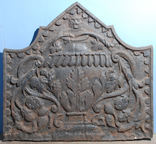

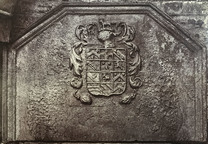

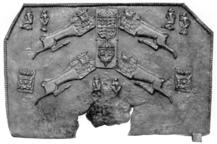
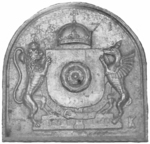
 23-10-12 686x.jpg)
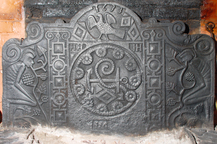

.jpg)